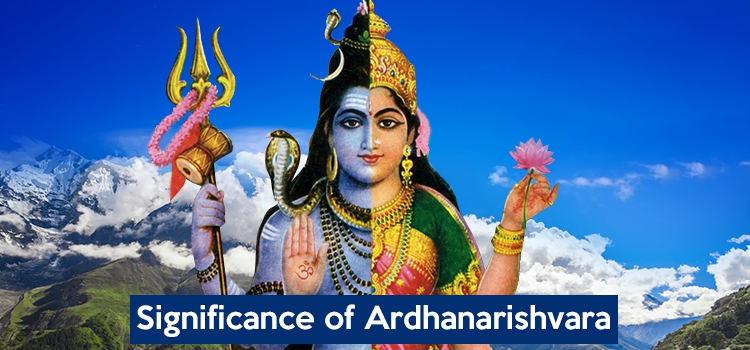Significance of Ardhanarishvara
Ardhanarishvara is one of the 64 forms of Lord Shiva, who is the Nirguna Brahman (the Supreme One who is beyond attributes).
This form is a composite and androgynous form of Shiva and his consort, Goddess Parvati. It is depicted as a fusion of half-male and half-female forms, which are split down in the center. While the right half is Shiva, the left half is Parvati.
Ardhanarishvara means "the Lord who is half-woman". Ardhanarishvara embodies Prakriti and Purusha, which are the feminine and masculine energies of the cosmos. It illustrates how Shakti, the Sacred Feminine, is inseparable from Shiva, God’s male principle.

Origin of Ardhanarishvara
The Ardhanarishvara concept dates back to both the ancient Hindu and Greek cultures. The earliest such images go back to the Kushan era, and records exist from the first century CE.
Ardhanarishvara iconography supposedly developed and evolved during the Gupta period. The form is present in many Shiva temples in India. Strangely, few temples are actually dedicated to this form.
As per the Brihadaranyaka Upanishad, this androgynous form occurs when Purusha split himself into two parts, male and female. All life was created when these two halves copulated.
Legends behind Ardhanarishvara
According to a Tamil legend, the Gods and the Rishis (sages) were visiting Mount Kailas (Shiva's abode) to pay their respects to Shiva and Parvati. But Rishi Bhringi wanted to worship only Shiva, and he ignored Parvati. So he circumambulated around Shiva. Parvati became angry and cursed Bhringi, saying he would lose all his flesh and blood. The sage became a mere skeleton. As Bhringi could not stand erect, Shiva gave him a third leg for support.
A hurt Parvati punished herself by doing severe austerities. Pleased, Shiva granted her the boon of uniting with him forever in the form of Ardhanarishvara. Now Bhringi had to worship her as well as Shiva. But the clever sage took the form of a beetle and circumambulated only the male half. He also drilled a hole in the deity’s navel area, which separated the male half from the female half. Parvati was amazed by the sage’s devotion to Shiva and blessed him.
Other Legends About Ardhanarishvara
There are many legends about Ardhanarishvara. The earliest ones occur in the Puranas. It also finds mention in the Mahabharata epic.
As per the Skanda Purana, Parvati wanted Shiva to stay with her forever and embraced him "limb-to-limb". Thus, Ardhanarishvara was formed.
The Matsya Purana says that Brahma was pleased with Parvati’s penance to him and gave her a golden complexion. This made her appear very attractive to Shiva, who merges with her to form Ardhanarishvara.
There is also another story. A demon, Andhaka, wanted to marry Parvati. Vishnu rescued her and brought her to Vaikunta. But Andhaka followed her there as well. Then, Parvati revealed her Ardhanarishvara form to him. On seeing this form, the demon lost interest in her. Even Vishnu was amazed to see this form. He also saw himself in the female half of Ardhanarishvara.
As per the Kalika Purana, Parvati felt that Shiva was being unfaithful to her when she saw her own reflection in Shiva's breast. They had an argument that ended quickly. Parvati wanted to stay with Shiva eternally, becoming one with him in the same body, thereby forming Ardhanarishvara.
Another story talks about Parvati feeling jealous when she saw Ganga sitting on Shiva's head. Though Shiva tried to please her by placing her on his lap, Parvati remained angry. So he united with her to form Ardhanarishvara.
The Shiva Purana says that Brahma or Prajapati, who created all male beings, found that creation had stalled. He approached Shiva for help. Shiva took the form of Ardhanarishvara, and Brahma asked the female half to help him create females so that the process of creation could continue. The Goddess then created many female powers from her body, after which creation gathered momentum.
A Tamil legend says that Goddess Uma (an aspect of Parvati) playfully closed Shiva’s eyes once, plunging the world into darkness. The Earth and all living creatures suffered because of this eternal darkness. Uma realized her folly and had to leave Kailas. She began to worship the Linga to get relief from her sin and reunite with Shiva. Lord Vishnu appeared before her and told her about the austerities she had to perform for this purpose. She began the penance accordingly. At this time, Mahishasura, an evil demon, began to create havoc on Earth. Then, Uma took the form of Goddess Durga and a fierce fight ensued. She slew him finally and the Lord then manifested as the Fire on top of the hill. He also merged with her and gave darshan as the Ardhanarishvara. Devotees celebrate the occasion as Deepavali and Ardhanarishvara blesses his devotees as Jyoti Swaroopa or Light.
According to several Puranas, Rudra, a form of Shiva, emerged from Brahma's forehead. Rudra’s intense heat burns Brahma. Brahma told him to divide himself and Rudra agreed. This created hundreds of beings, including the 11 Rudras and female Shaktis. The Goddess then reunited with Shiva and promised to take rebirth as Sati and marry him in human form, too. Ardhanarishvara form then enjoyed his own other half using the "Path of Yoga" and created Brahma and Vishnu from her body. Supposedly, when each new Yuga (epoch) begins, Ardhanarishvara reappears and brings forth new creation on Earth.
Symbolism of Ardhanarishvara
The Ardhanarishvara concept has a deep inner meaning. He symbolizes the balance of the male and female energies in the world and indicates that they are inseparable and complementary forces, which are essential to maintain equilibrium. It shows that despite being opposites, Purusha and Prakrity have unity.
Purusha signifies the passive force of the universe, and Prakriti is the active and dynamic force. Both of them need to merge with each other to generate and sustain the universe. This idea is also expressed by the union of Shiva’s Linga with the Yoni of the Goddess. Their union leads to the birth of the entire cosmos. The Ardhanarishvara concept also signifies Kama or lust, which is essential for procreation.
Ardhanarishvara also indicates that both the masculine and feminine energies are equal. They are two equal parts of the Supreme Being, making the whole.
Shiva's half holds a rosary which indicates asceticism. Parvati's half holds a mirror that embodies the material and illusory world. Thus, the fusion of these two opposites suggests that both the material and spiritual spheres need to coexist in one's life if it is to be complete.Hermaphrodite icons like Ardhanarishvara are symbols of fecundity and boundless growth in diverse cultures. Shiva’s embrace of Parvati suggests the fertility of Nature as well. These two opposing forces then become one so that it is not possible to locate the masculine in the feminine and vice-versa.
The female half is usually located to the left and the male half to the right. The right side is linked to male traits like valor, aggression, logic, direction, systematic thought, etc. The left side is associated with feminine traits like creativity, intuition, etc.
Worship of Ardhanarishvara
Ardhanarishvara is a popular aspect of Shiva, and the form is worshipped in some Shiva temples in India and South-east Asia. Many devotees worship Ardhanarishvara to get salvation from the material world. The renowned Nayanars (Shaivite poet-saints) of Tamil Nadu gave Ardhararishvara an exalted status in their works. The Ardhanarinateshwara Stotra enjoys great popularity among devotees. Many practitioners of Tantra consider Ardhanarishvara as their tutelary deity.
Devotees worship Lord Ardhanarishvara for wish-fulfillment and spiritual progress. They often perform Ardhanarishvara Pooja and Ardhanarishvara Homam to invoke the blessings of Shiva and Parvati.
Ardhanarishwar Pooja/Homa Benefits:
- Gets rid of sins and bad karmas
- Enables spiritual progress and wish-fulfillment
- Creates peace and harmony in marital life
- Invokes the blessings of Shiva and Shakti




















